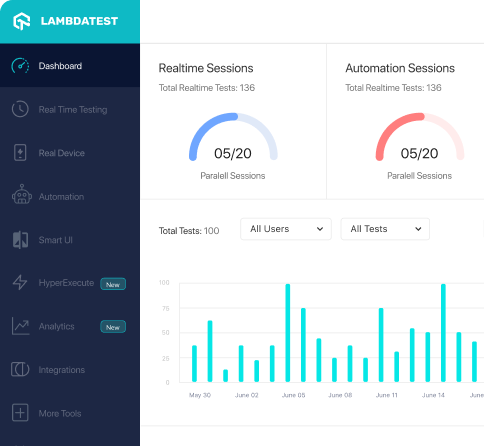How to use AtomicReferenceArrayAssert_hasSize_Test class of org.assertj.core.api.atomic.referencearray package
Best Assertj code snippet using org.assertj.core.api.atomic.referencearray.AtomicReferenceArrayAssert_hasSize_Test
...13package org.assertj.core.api.atomic.referencearray;14import org.assertj.core.api.AtomicReferenceArrayAssert;15import org.assertj.core.api.AtomicReferenceArrayAssertBaseTest;16import static org.mockito.Mockito.verify;17public class AtomicReferenceArrayAssert_hasSize_Test extends AtomicReferenceArrayAssertBaseTest {18 @Override19 protected AtomicReferenceArrayAssert<Object> invoke_api_method() {20 return assertions.hasSize(6);21 }22 @Override23 protected void verify_internal_effects() {24 verify(arrays).assertHasSize(info(), internalArray(), 6);25 }26}...AtomicReferenceArrayAssert_hasSize_Test
Using AI Code Generation
1package org.assertj.core.api.atomic.referencearray;2import static org.assertj.core.api.Assertions.assertThat;3import static org.mockito.Mockito.verify;4import org.assertj.core.api.AtomicReferenceArrayAssert;5import org.assertj.core.api.AtomicReferenceArrayAssertBaseTest;6public class AtomicReferenceArrayAssert_hasSize_Test extends AtomicReferenceArrayAssertBaseTest {7 protected AtomicReferenceArrayAssert<Object> invoke_api_method() {8 return assertions.hasSize(6);9 }10 protected void verify_internal_effects() {11 verify(arrays).assertHasSize(getInfo(assertions), getActual(assertions), 6);12 }13}14package org.assertj.core.api.atomic.referencearray;15import static org.assertj.core.api.Assertions.assertThat;16import static org.mockito.Mockito.verify;17import org.assertj.core.api.AtomicReferenceArrayAssert;18import org.assertj.core.api.AtomicReferenceArrayAssertBaseTest;19public class AtomicReferenceArrayAssert_hasSize_Test extends AtomicReferenceArrayAssertBaseTest {20 protected AtomicReferenceArrayAssert<Object> invoke_api_method() {21 return assertions.hasSize(6);22 }23 protected void verify_internal_effects() {24 verify(arrays).assertHasSize(getInfo(assertions), getActual(assertions), 6);25 }26}27package org.assertj.core.api.atomic.referencearray;28import static org.assertj.core.api.Assertions.assertThat;29import static org.mockito.Mockito.verify;30import org.assertj.core.api.AtomicReferenceArrayAssert;31import org.assertj.core.api.AtomicReferenceArrayAssertBaseTest;32public class AtomicReferenceArrayAssert_hasSize_Test extends AtomicReferenceArrayAssertBaseTest {33 protected AtomicReferenceArrayAssert<Object> invoke_api_method() {34 return assertions.hasSize(6);35 }36 protected void verify_internal_effects() {37 verify(arrays).assertHasSize(getInfo(assertions), getActual(assertions), 6);38 }39}40package org.assertj.core.api.atomic.referencearray;41import static org.assertj.core.api.Assertions.assertThat;42import static org.mockito.Mockito.verify;43import org.assertj.core.api.AtomicReferenceArrayAssert;44import org.assertj.core.api.AtomicReferenceArrayAssertBaseTest;AtomicReferenceArrayAssert_hasSize_Test
Using AI Code Generation
1import org.assertj.core.api.Assertions;2import org.assertj.core.api.AtomicReferenceArrayAssert;3import org.assertj.core.api.AtomicReferenceArrayAssert_hasSize_Test;4public class AtomicReferenceArrayAssert_hasSize_Test_toString {5 public static void main(String[] args) {6 AtomicReferenceArrayAssert<Object> assertions = Assertions.assertThat(new AtomicReferenceArrayAssert_hasSize_Test().actual);7 System.out.println(assertions.hasSize(10).toString());8 }9}10 AtomicReferenceArrayAssert<Object> assertions = Assertions.assertThat(new AtomicReferenceArrayAssert_hasSize_Test().actual);11 System.out.println(assertions.hasSize(10).toString());12 symbol: method hasSize(int)AtomicReferenceArrayAssert_hasSize_Test
Using AI Code Generation
1package org.assertj.core.api.atomic.referencearray;2import org.junit.jupiter.api.Test;3import org.assertj.core.api.AtomicReferenceArrayAssert;4import org.assertj.core.api.Assertions;5import org.assertj.core.api.AtomicReferenceArrayAssertBaseTest;6import org.assertj.core.util.FailureMessages;7import static org.mockito.Mockito.verify;8public class AtomicReferenceArrayAssert_hasSize_Test extends AtomicReferenceArrayAssertBaseTest {9 public void should_pass_if_size_of_actual_is_equal_to_expected_size() {10 assertions.hasSize(1);11 }12 public void should_fail_if_size_of_actual_is_not_equal_to_expected_size() {13 int expectedSize = 6;14 AssertionError assertionError = Assertions.catchThrowableOfType(() -> assertions.hasSize(expectedSize), AssertionError.class);15 then(assertionError).hasMessage(FailureMessages.actualIsNull());16 }17 public void should_fail_and_display_description_of_assertion_if_actual_is_null() {18 String description = "Test";19 AssertionError assertionError = Assertions.catchThrowableOfType(() -> new AtomicReferenceArrayAssert<>(null).as(description).hasSize(1), AssertionError.class);20 then(assertionError).hasMessage(String.format("%n" +21 " <Test>"));22 }23 public void should_fail_with_custom_message_if_actual_is_null() {24 String message = "My custom message";25 AssertionError assertionError = Assertions.catchThrowableOfType(() -> new AtomicReferenceArrayAssert<>(null).overridingErrorMessage(message).hasSize(1), AssertionError.class);26 then(assertionError).hasMessage(message);27 }28 public void should_fail_with_custom_message_ignoring_description_of_assertion_if_actual_is_null() {29 String description = "Test";30 String message = "My custom message";31 AssertionError assertionError = Assertions.catchThrowableOfType(() -> new AtomicReferenceArrayAssert<>(null).as(description).overridingErrorMessage(message).hasSize(1), AssertionError.classAtomicReferenceArrayAssert_hasSize_Test
Using AI Code Generation
1package org.assertj.core.api.atomic.referencearray;2import static org.assertj.core.api.Assertions.assertThat;3import static org.assertj.core.error.ShouldHaveSize.shouldHaveSize;4import static org.assertj.core.util.Arrays.array;5import static org.assertj.core.util.FailureMessages.actualIsNull;6import org.assertj.core.api.AtomicReferenceArrayAssert;7import org.assertj.core.api.AtomicReferenceArrayAssertBaseTest;8import org.assertj.core.internal.Failures;9import org.assertj.core.internal.StandardComparisonStrategy;10import org.junit.jupiter.api.DisplayName;11import org.junit.jupiter.api.Test;12public class AtomicReferenceArrayAssert_hasSize_Test extends AtomicReferenceArrayAssertBaseTest {13 private static final String[] ACTUAL = array("Yoda", "Luke");14 protected AtomicReferenceArrayAssert<String> invoke_api_method() {15 return assertions.hasSize(2);16 }17 protected void verify_internal_effects() {18 verify(arrays).assertHasSize(getInfo(assertions), getActual(assertions), 2);19 }20 @DisplayName("should pass when the size of the actual AtomicReferenceArray matches the given size")21 public void should_pass_if_size_of_actual_is_equal_to_expected_size() {22 AtomicReferenceArrayAssert<String> assertions = new AtomicReferenceArrayAssert<>(ACTUAL);23 assertions.hasSize(2);24 }25 @DisplayName("should fail when the size of the actual AtomicReferenceArray does not match the given size")26 public void should_fail_if_size_of_actual_is_not_equal_to_expected_size() {27 AtomicReferenceArrayAssert<String> assertions = new AtomicReferenceArrayAssert<>(ACTUAL);28 AssertionError error = expectAssertionError(() -> assertions.hasSize(3));29 assertThat(error).hasMessage(shouldHaveSize(ACTUAL, ACTUAL.length, 3).create());30 }31 @DisplayName("should fail when the actual AtomicReferenceArray is null")32 public void should_fail_if_actual_is_null() {Blogs
Check out the latest blogs from LambdaTest on this topic:
One of the essential parts when performing automated UI testing, whether using Selenium or another framework, is identifying the correct web elements the tests will interact with. However, if the web elements are not located correctly, you might get NoSuchElementException in Selenium. This would cause a false negative result because we won’t get to the actual functionality check. Instead, our test will fail simply because it failed to interact with the correct element.
The count of mobile users is on a steep rise. According to the research, by 2025, it is expected to reach 7.49 billion users worldwide. 70% of all US digital media time comes from mobile apps, and to your surprise, the average smartphone owner uses ten apps per day and 30 apps each month.
How do we acquire knowledge? This is one of the seemingly basic but critical questions you and your team members must ask and consider. We are experts; therefore, we understand why we study and what we should learn. However, many of us do not give enough thought to how we learn.
I was once asked at a testing summit, “How do you manage a QA team using scrum?” After some consideration, I realized it would make a good article, so here I am. Understand that the idea behind developing software in a scrum environment is for development teams to self-organize.
Coaching is a term that is now being mentioned a lot more in the leadership space. Having grown successful teams I thought that I was well acquainted with this subject.
Automation Testing Tutorials
Learn to execute automation testing from scratch with LambdaTest Learning Hub. Right from setting up the prerequisites to run your first automation test, to following best practices and diving deeper into advanced test scenarios. LambdaTest Learning Hubs compile a list of step-by-step guides to help you be proficient with different test automation frameworks i.e. Selenium, Cypress, TestNG etc.
LambdaTest Learning Hubs:
- JUnit Tutorial
- TestNG Tutorial
- Webdriver Tutorial
- WebDriverIO Tutorial
- Protractor Tutorial
- Selenium 4 Tutorial
- Jenkins Tutorial
- NUnit Tutorial
- Jest Tutorial
- Playwright Tutorial
- Cypress Tutorial
- PyTest Tutorial
YouTube
You could also refer to video tutorials over LambdaTest YouTube channel to get step by step demonstration from industry experts.
Most used methods in AtomicReferenceArrayAssert_hasSize_Test
Try LambdaTest Now !!
Get 100 minutes of automation test minutes FREE!!



